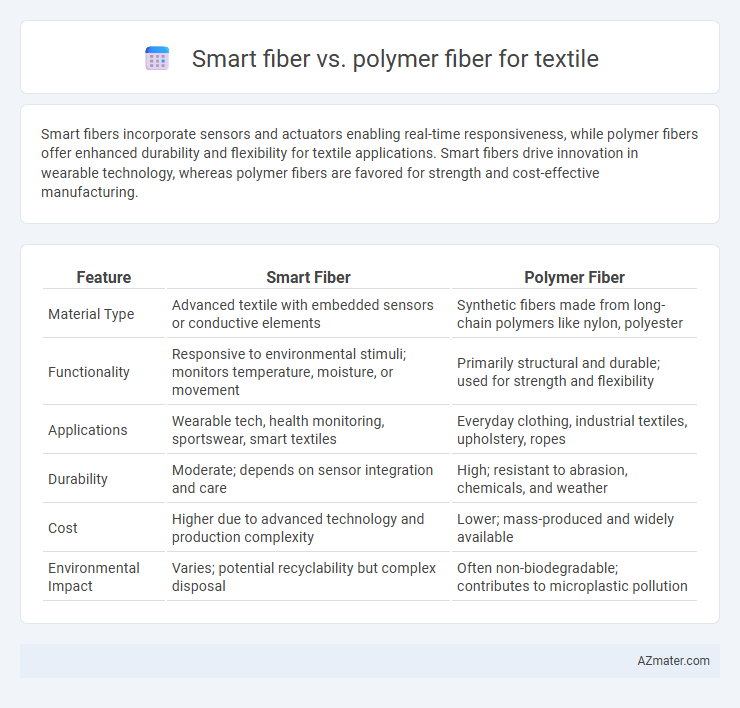Smart fibers incorporate sensors and actuators enabling real-time responsiveness, while polymer fibers offer enhanced durability and flexibility for textile applications. Smart fibers drive innovation in wearable technology, whereas polymer fibers are favored for strength and cost-effective manufacturing.
Table of Comparison
| Feature | Smart Fiber | Polymer Fiber |
|---|---|---|
| Material Type | Advanced textile with embedded sensors or conductive elements | Synthetic fibers made from long-chain polymers like nylon, polyester |
| Functionality | Responsive to environmental stimuli; monitors temperature, moisture, or movement | Primarily structural and durable; used for strength and flexibility |
| Applications | Wearable tech, health monitoring, sportswear, smart textiles | Everyday clothing, industrial textiles, upholstery, ropes |
| Durability | Moderate; depends on sensor integration and care | High; resistant to abrasion, chemicals, and weather |
| Cost | Higher due to advanced technology and production complexity | Lower; mass-produced and widely available |
| Environmental Impact | Varies; potential recyclability but complex disposal | Often non-biodegradable; contributes to microplastic pollution |
Overview: Smart Fiber and Polymer Fiber in Modern Textiles
Smart fibers in modern textiles incorporate advanced materials like conductive polymers and shape-memory alloys, enabling responsive functions such as temperature regulation, moisture sensing, and energy harvesting. Polymer fibers, including nylon, polyester, and polypropylene, provide durability, elasticity, and lightweight characteristics essential for everyday textile applications and performance wear. Combining smart fibers with polymer matrices enhances textile innovation by merging functionality with comfort and structural integrity.
Composition and Structure Differences
Smart fibers typically incorporate advanced materials such as carbon nanotubes, conductive polymers, or shape-memory alloys, providing responsive functionalities, whereas polymer fibers like polyester or nylon are composed of long-chain synthetic polymers designed for strength and flexibility. The structure of smart fibers often features embedded nanomaterials or multilayered architectures enabling sensing or actuation, contrasting with the homogeneous microstructure of conventional polymer fibers. These compositional and structural differences result in distinct performance characteristics, with smart fibers offering adaptive behavior and polymer fibers delivering durability and ease of processing.
Functional Properties of Smart Fibers
Smart fibers exhibit advanced functional properties such as responsiveness to stimuli like temperature, moisture, and UV light, enabling real-time adaptation in textiles. These fibers provide enhanced performance features including shape memory, self-cleaning, and conductivity for wearable electronics, surpassing traditional polymer fibers. Polymer fibers primarily offer structural support and durability, whereas smart fibers integrate intelligent functionalities that improve comfort, safety, and energy efficiency in textile applications.
Key Features of Polymer Fibers
Polymer fibers in textiles offer superior durability, elasticity, and resistance to chemicals compared to smart fibers, making them ideal for high-performance and everyday wear applications. These fibers provide excellent moisture-wicking capabilities and thermal insulation, enhancing comfort and functionality in various environments. Their cost-effectiveness and ease of processing further contribute to widespread use in fashion, industrial, and technical textiles.
Performance Comparison in Textile Applications
Smart fibers in textile applications exhibit enhanced properties such as conductivity, responsiveness to stimuli, and self-healing capabilities compared to traditional polymer fibers like nylon or polyester, which primarily offer durability and flexibility. Performance metrics favor smart fibers for advanced uses due to their integration with sensors and adaptability, whereas polymer fibers maintain superiority in cost-efficiency and mechanical strength. The choice between smart and polymer fibers depends on balancing innovation-driven functionality with conventional textile performance standards.
Durability and Maintenance Factors
Smart fibers in textiles exhibit enhanced durability due to their ability to self-repair and resist environmental damage, significantly extending fabric lifespan compared to traditional polymer fibers. Polymer fibers, while cost-effective and widely used, often require more frequent maintenance as they tend to degrade faster under UV exposure, moisture, and mechanical stress. Maintenance factors favor smart fibers through reduced washing frequency and lower susceptibility to wear, contributing to sustained textile performance and reduced long-term costs.
Sustainability and Environmental Impact
Smart fibers, often embedded with sensors or responsive materials, offer advanced functionality but typically involve complex manufacturing processes that may increase environmental footprints compared to polymer fibers. Polymer fibers, especially bio-based or recycled variants like PLA or recycled PET, provide greater sustainability benefits through reduced resource consumption and enhanced recyclability. Choosing polymer fibers over smart fibers can significantly lower energy use and greenhouse gas emissions across the textile lifecycle.
Cost Analysis: Smart vs. Polymer Fibers
Smart fibers, integrating sensors and responsive elements, typically incur higher initial costs compared to traditional polymer fibers due to advanced manufacturing processes and embedded technology. Polymer fibers, such as nylon, polyester, and polypropylene, offer cost-effective solutions with established supply chains and mass production scalability. Long-term cost analysis favors polymer fibers for bulk textile applications, while smart fibers justify their premium through enhanced functionality in specialized markets like wearable technology and medical textiles.
Current Innovations and Future Trends
Smart fibers incorporate advanced materials like piezoelectric polymers and conductive polymers, enabling textiles to sense, respond, and adapt to environmental stimuli for applications in wearable technology and health monitoring. Polymer fibers, especially high-performance types such as aramid and polyethylene, continue to evolve with enhanced strength, flexibility, and lightweight properties, supporting the development of protective and functional textiles. Future trends emphasize integrating nanotechnology and bio-based polymers to create eco-friendly, multifunctional smart textiles with improved durability, energy harvesting capabilities, and real-time data processing.
Choosing the Right Fiber for Textile Needs
Smart fiber offers advanced functionalities such as moisture management, temperature regulation, and UV protection, making it ideal for high-performance textiles. Polymer fiber, known for its durability, elasticity, and cost-effectiveness, suits everyday wear and industrial applications. Choosing the right fiber depends on the end-use requirements, balancing performance features with budget constraints.

Infographic: Smart fiber vs Polymer fiber for Textile
 azmater.com
azmater.com